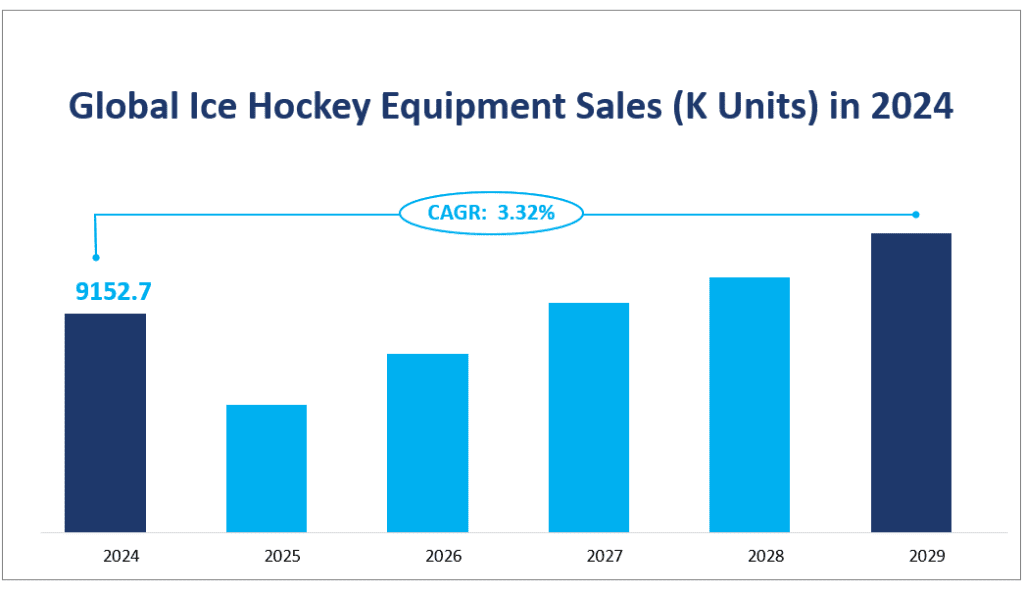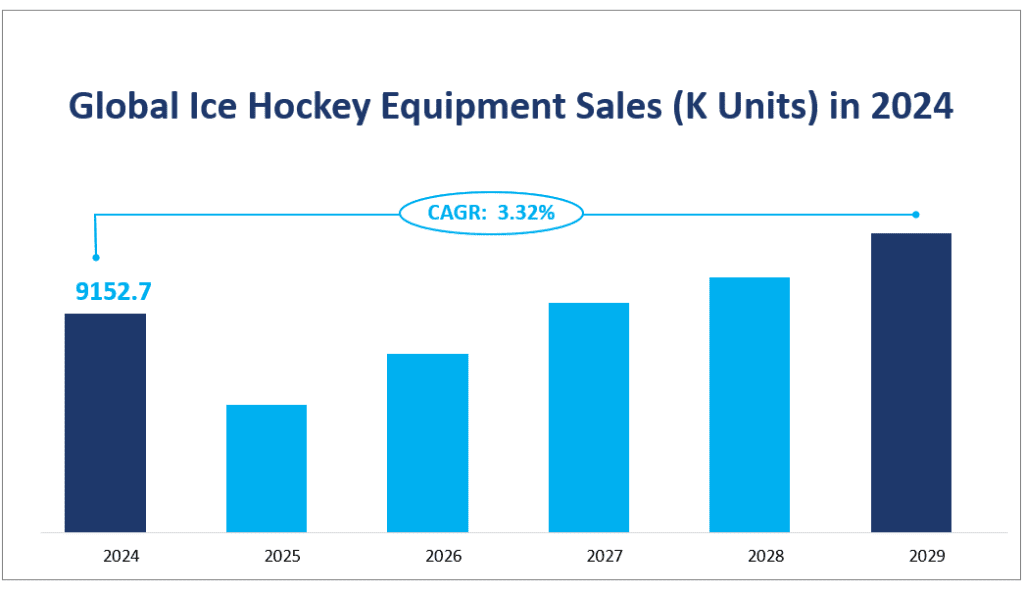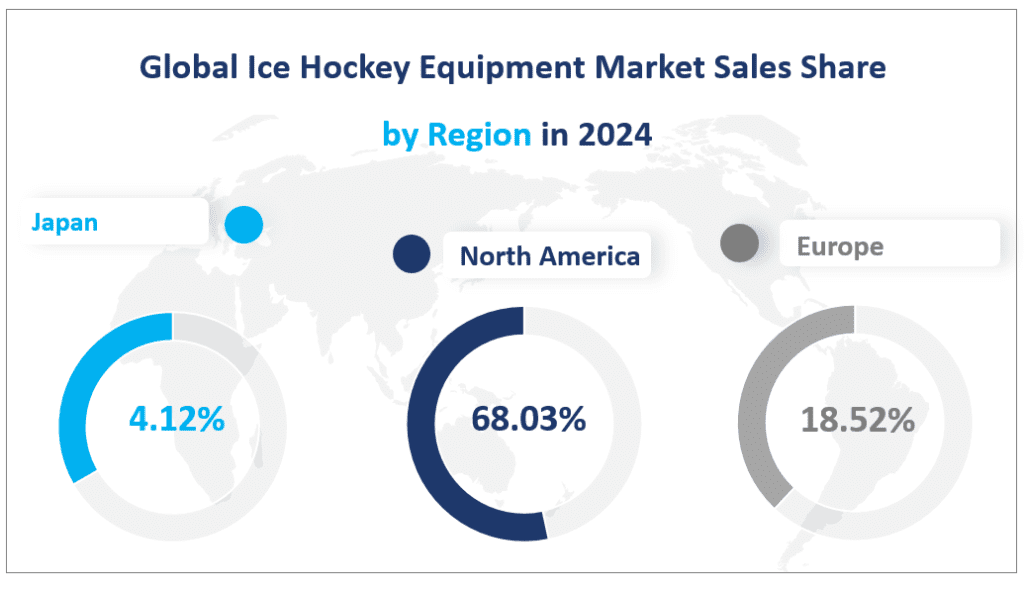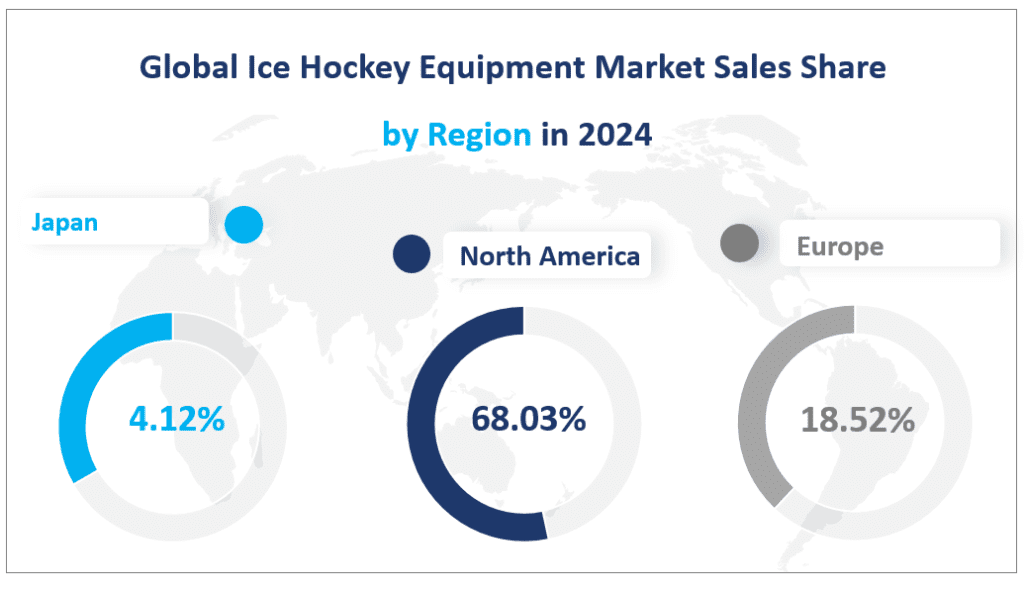1. Global Ice Hockey Equipment Market Growth
The global ice hockey equipment market sales will reach 9152.7 K Units with a CAGR of 3.32% from 2024 to 2029.
The ice hockey equipment market serves a wide range of applications, from amateur and youth hockey leagues to professional teams, contributing to a diverse end-use scope. The necessity of these products is driven by the high-impact nature of the sport, requiring players to have specialized gear that enhances performance while ensuring safety. This market is influenced by several dynamic factors, including changing consumer preferences, technological advancements, regulatory standards, and economic conditions. Understanding and adapting to these dynamics is crucial for manufacturers and industry participants to stay competitive and capitalize on emerging opportunities.
Global Ice Hockey Equipment Market Sales (K Units) in 2024


2. Driving Factors of Ice Hockey Equipment Market
Rising Popularity of Ice Hockey: The growing popularity of ice hockey, particularly in regions like North America and Europe, is a significant driver for the equipment and gear market. More youth and adult leagues are being established, which encourages players to invest in quality gear to enhance their performance and safety on the ice.
Technological Advancements in Equipment: Continuous innovation in materials and design has led to the development of advanced ice hockey gear. For instance, lighter and more durable materials improve player performance and comfort. Companies are increasingly incorporating technologies such as moisture-wicking fabrics, enhanced protection features, and customizable gear, making the equipment more appealing to consumers.
Rising Awareness of Player Safety: With an increased focus on safety in sports, there is a growing demand for protective gear that meets higher safety standards. Awareness of injuries, particularly concussions, has prompted players and parents to seek out advanced protective equipment, boosting sales in the market.
Expansion into New Markets: The increasing popularity of ice hockey in emerging economies presents significant growth opportunities for equipment manufacturers. As the sport gains traction in regions like Asia and South America, there is a growing demand for ice hockey equipment.
E-Commerce and Direct-to-Consumer Sales: The rise of e-commerce platforms and online marketplaces provides an opportunity for equipment manufacturers to reach a broader consumer base. Effective digital marketing strategies, user-friendly websites, and seamless customer experiences can drive online sales.
3. Limiting Factors of Ice Hockey Equipment Market
High Cost of Equipment: The initial investment for quality ice hockey equipment can be quite high, which may deter potential players, especially at the youth level. Families may find it challenging to afford the necessary gear, limiting participation and market growth.
Seasonal Nature of the Sport: Ice hockey is primarily a winter sport, leading to fluctuations in demand for equipment throughout the year. This seasonality can impact manufacturers and retailers, affecting inventory management and sales strategies.
Intense Competition: The market is highly competitive, with the presence of several established players and numerous emerging brands. Key manufacturers in the market include Bauer Hockey, CCM Hockey, Warrior Sports, Easton Hockey, and Sher-Wood Hockey. These companies compete based on product quality, performance, durability, innovation, and brand reputation.
Economic Instability: Economic fluctuations affect consumer spending on non-essential items such as sports equipment. During economic downturns, consumers may reduce their spending on sports equipment, impacting the market.
Compliance with Safety Standards: Compliance with safety standards and regulations makes production processes more complex and expensive. Manufacturers need to ensure that their products meet these standards, which can increase production costs.
4. Analysis of Ice Hockey Equipment Market Product Types in 2024
Product Type Analysis
Among these product types, Protective Gear holds the largest market share, accounting for approximately 42.96% with sales of 3931.7 K Units in 2024. This is not surprising, as protective gear is essential for the safety of ice hockey players, encompassing a wide range of items such as helmets, shoulder pads, chest protectors, elbow pads, gloves, and shin guards. The importance of player safety in the sport drives the demand for high-quality protective gear, ensuring that players are well-protected during games and practices. On the other hand, Ice Skates and Sticks also constitute significant portions of the market, with shares of 26.12% and 22.28% respectively in 2024.
Ice skates are a fundamental component of the sport, providing players with the mobility and agility required to navigate the ice. The demand for ice skates is driven by the need for performance-enhancing features such as better blade technology and more comfortable boot designs. Similarly, sticks are crucial for players to handle the puck, shoot, and pass, making them an indispensable part of the equipment set.
Applications Analysis
Specialty and Sports Shops dominate the market with the largest share, accounting for 63.52% with sales of 5,813.9 K Units in 2024. These shops are specialized in sports equipment and offer a wide variety of ice hockey gear, often with expert advice and personalized service. The high market share reflects the preference of consumers for purchasing equipment from stores that can provide them with the best selection and support.
Online Retail is the second-largest application, with a market share of 21.49% with sales of 1,967.0 K Units in 2024. The growth of e-commerce has significantly impacted the sports equipment market, offering consumers the convenience of shopping from home and accessing a broader range of products.
Department and Discount Stores have a smaller market share of 6.04%, but they still play a role in the market by offering a more general selection of sports equipment at competitive prices.
Market Sales and Share by Segment
| Sales (K Units) in 2024 | Market Share in 2024 | ||
| By Type | Protective Gear | 3931.7 | 42.96% |
| Ice Skates | 2391.1 | 26.12% | |
| Sticks | 2039.5 | 22.28% | |
| By Application | Specialty and Sports Shops | 5813.9 | 63.52% |
| Department and Discount Stores | 552.8 | 6.04% | |
| Online Retail | 1967.0 | 21.49% | |
| Others | 819.0 | 8.95% |
5. Regional Ice Hockey Equipment Market
North America: The Dominant Market
North America stands out as the largest regional ice hockey equipment market for ice hockey equipment, with sales reaching 6,226.6 K Units in 2024. Ice hockey has a long and storied history in North America, particularly in the United States and Canada. The sport is deeply ingrained in the culture, with a large fan base and a significant number of professional and amateur leagues. This historical popularity has led to a consistent demand for high-quality ice hockey equipment.
The National Hockey League (NHL) is based in North America and is one of the most prestigious professional ice hockey leagues in the world. The presence of the NHL and other professional leagues drives the demand for top-tier equipment, as players and teams seek the best gear to enhance performance and ensure safety. The region’s relatively high disposable income levels allow consumers to invest in premium ice hockey equipment. This has led to a market that not only demands a large volume of equipment but also seeks high-quality and technologically advanced products.
Europe: A Strong and Growing Market
Europe is the second-largest ice hockey equipment market, with sales of 1,694.8 K Units in 2024. Europe has a robust professional ice hockey scene, with leagues such as the Kontinental Hockey League (KHL) and various national leagues. Ice hockey is popular in many European countries, with a strong fan base and a rich tradition of the sport. This cultural enthusiasm translates into a steady demand for equipment across the region.
Europe is a diverse market with different levels of development and consumer preferences. While some countries have well-established ice hockey cultures, others are experiencing growth in the sport. This diversity provides opportunities for both established and emerging brands.
China: The Emerging Giant
China is an emerging market with significant potential for growth. In 2024, sales reached 216.0 K Units. The Chinese government has been promoting winter sports, including ice hockey, as part of its strategy to develop the sports industry. Initiatives such as the “300 million people on ice” plan have led to increased participation in ice hockey and other winter sports.
Infrastructure Development: There has been a significant increase in the number of ice rinks and training facilities in China, making it more accessible for people to participate in the sport. This infrastructure development is expected to drive further growth in equipment sales. The growing middle class in China has more disposable income to spend on sports equipment. As interest in ice hockey grows, this demographic is expected to drive demand for both entry-level and high-end equipment.
While North America remains the largest market, China is the fastest-growing region. This growth rate is significantly higher than that of other regions, indicating the potential for a major shift in the global ice hockey equipment market dynamics.
The rapid growth in China can be attributed to the combination of government support, infrastructure development, and the rising middle class. These factors are creating a fertile ground for the expansion of the ice hockey equipment market. As more people in China take up the sport, the demand for equipment is expected to continue to rise, presenting significant opportunities for manufacturers and suppliers.
Global Ice Hockey Equipment Market Sales Share by Region in 2024


6. Top 3 Companies in the Ice Hockey Equipment Market
Bauer Hockey is the world’s leading designer, developer, manufacturer, and marketer of ice hockey equipment. Founded in 1927 in Kitchener, Ontario, Bauer has a strong global presence and is known for its innovative products and high-quality equipment. The company offers a wide range of products, including skates, sticks, helmets, protective gear, and apparel.
Bauer’s product line includes high-performance skates, lightweight sticks, advanced protective gear, and customizable apparel. Their AG5NT stick, launched in October 2022, is a notable product featuring XE taper technology and dynamic quick-release technology, designed to enhance player performance.
Company Introduction and Business Overview: CCM Hockey is a leading designer, manufacturer, and marketer of ice hockey equipment and related apparel. With its headquarters in Montreal, CCM operates in Canada, the United States, and Europe. The company is known for equipping more professional hockey players than any other company, including several NHL stars.
CCM offers a comprehensive range of ice hockey equipment, including skates, sticks, helmets, and protective gear. Their products are designed to meet the needs of professional and amateur players, with a focus on performance and durability.
Warrior Sports is a premier manufacturer of innovative, high-performance equipment, footwear, and apparel for lacrosse and hockey athletes. Founded in 1992 in Warren, Michigan, Warrior Sports is known for its cutting-edge products and strong brand reputation.
Warrior Sports offers a wide range of ice hockey equipment, including sticks, protective gear, and apparel. Their products are designed to enhance player performance and safety, with a focus on innovation and technology.
Major Players
| Company Name | Manufacturing Sites | Business Distribution Region |
| BAUER | Mainly in North America | Worldwide |
| CCM | Mainly in North America | Mainly in North America and Europe |
| Sher-Wood | Mainly in Canada | Mainly in North America and Europe |
| Warrior Sports | Mainly in North America | Mainly in North America and Europe |
| Franklin Sports | Mainly in North America | Mainly in North America and Europe |
| Graf | Mainly in Switzerland | Mainly in Europe, North America and Asia |
| Tour Hockey | Mainly in USA | Mainly in North America |
1 Ice Hockey Equipment Market Overview
1.1 Ice Hockey Equipment Product Scope
1.2 Ice Hockey Equipment Segment by Type
1.2.1 Global Ice Hockey Equipment Sales by Type (2016 & 2021 & 2027)
1.2.2 Protective Gear
1.2.3 Ice Skates
1.2.4 Sticks
1.3 Market by Application
1.3.1 Global Ice Hockey Equipment Sales Comparison by Application (2016 & 2021 & 2027)
1.3.2 Specialty and Sports Shops
1.3.3 Department and Discount Stores
1.3.4 Online Retail
1.4 Ice Hockey Equipment Market Estimates and Forecasts (2016-2027)
1.4.1 Global Ice Hockey Equipment Market Size in Value Growth Rate (2016-2027)
1.4.2 Global Ice Hockey Equipment Market Size in Volume Growth Rate (2016-2027)
1.4.3 Global Ice Hockey Equipment Price Trends (2016-2027)
2 Ice Hockey Equipment Estimate and Forecast by Region
2.1 Global Ice Hockey Equipment Market Size by Region: 2016 VS 2021 VS 2027
2.2 Global Ice Hockey Equipment Retrospective Market Scenario by Region (2016-2021)
2.2.1 Ice Hockey Equipment Sales by Region (2016-2021)
2.2.2 Global Ice Hockey Equipment Revenue by Region (2016-2021)
2.3 Global Ice Hockey Equipment Market Estimates and Forecasts by Region (2021-2027)
2.3.1 Global Ice Hockey Equipment Sales Estimates and Forecasts by Region (2021-2027)
2.3.2 Global Ice Hockey Equipment Revenue Forecast by Region (2021-2027)
2.4 Geographic Market Analysis: Market Facts & Figures
2.4.1 North America Ice Hockey Equipment Estimates and Projections (2016-2027)
2.4.2 Europe Ice Hockey Equipment Estimates and Projections (2016-2027)
2.4.3 China Ice Hockey Equipment Estimates and Projections (2016-2027)
2.4.4 Japan Ice Hockey Equipment Estimates and Projections (2016-2027)
2.4.5 Southeast Asia Ice Hockey Equipment Estimates and Projections (2016-2027)
2.4.6 India Ice Hockey Equipment Estimates and Projections (2016-2027)
3 Global Ice Hockey Equipment Competition Landscape by Players
3.1 Global Top Ice Hockey Equipment Players by Sales (2016-2021)
3.2 Global Top Ice Hockey Equipment Players by Revenue (2016-2021)
3.3 Global Ice Hockey Equipment Market Share by Company Type (Tier 1, Tier 2 and Tier 3) (based on the Revenue in Ice Hockey Equipment as of 2020)
3.4 Global Ice Hockey Equipment Average Price by Company (2016-2021)
3.5 Manufacturers Ice Hockey Equipment Manufacturing Sites, Area Served, Product Type
3.6 Manufacturers Mergers & Acquisitions, Expansion Plans
4 Global Ice Hockey Equipment Market Size by Type
4.1 Global Ice Hockey Equipment Historic Market Review by Type (2016-2021)
4.1.1 Global Ice Hockey Equipment Sales Market Share by Type (2016-2021)
4.1.2 Global Ice Hockey Equipment Revenue Market Share by Type (2016-2021)
4.1.3 Global Ice Hockey Equipment Price by Type (2016-2021)
4.2 Global Ice Hockey Equipment Market Estimates and Forecasts by Type (2021-2027)
4.2.1 Global Ice Hockey Equipment Sales Forecast by Type (2021-2027)
4.2.2 Global Ice Hockey Equipment Revenue Forecast by Type (2021-2027)
4.2.3 Global Ice Hockey Equipment Price Forecast by Type (2021-2027)
5 Global Ice Hockey Equipment Market Size by Application
5.1 Global Ice Hockey Equipment Historic Market Review by Application (2016-2021)
5.1.1 Global Ice Hockey Equipment Sales Market Share by Application (2016-2021)
5.1.2 Global Ice Hockey Equipment Revenue Market Share by Application (2016-2021)
5.1.3 Global Ice Hockey Equipment Price by Application (2016-2021)
5.2 Global Ice Hockey Equipment Market Estimates and Forecasts by Application (2021-2027)
5.2.1 Global Ice Hockey Equipment Sales Forecast by Application (2021-2027)
5.2.2 Global Ice Hockey Equipment Revenue Forecast by Application (2021-2027)
5.2.3 Global Ice Hockey Equipment Price Forecast by Application (2021-2027)
6 North America Ice Hockey Equipment Market Facts & Figures
6.1 North America Ice Hockey Equipment Sales Market Share by Company (2016-2021)
6.1.1 North America Ice Hockey Equipment Sales by Company
6.1.2 North America Ice Hockey Equipment Revenue by Company in 2020
6.2 North America Ice Hockey Equipment Sales Breakdown by Type
6.2.1 North America Ice Hockey Equipment Sales Breakdown by Type (2016-2021)
6.2.2 North America Ice Hockey Equipment Sales Breakdown by Type (2021-2027)
6.3 North America Ice Hockey Equipment Sales Breakdown by Application
6.3.1 North America Ice Hockey Equipment Sales Breakdown by Application (2016-2021)
6.3.2 North America Ice Hockey Equipment Sales Breakdown by Application (2021-2027)
7 Europe Ice Hockey Equipment Market Facts & Figures
7.1 Europe Ice Hockey Equipment Sales Market Share by Company in 2020
7.1.1 Europe Ice Hockey Equipment Sales by Company
7.1.2 Europe Ice Hockey Equipment Revenue by Company in 2020
7.2 Europe Ice Hockey Equipment Sales Breakdown by Type
7.2.1 Europe Ice Hockey Equipment Sales Breakdown by Type (2016-2021)
7.2.2 Europe Ice Hockey Equipment Sales Breakdown by Type (2021-2027)
7.3 Europe Ice Hockey Equipment Sales Breakdown by Application
7.3.1 Europe Ice Hockey Equipment Sales Breakdown by Application (2016-2021)
7.3.2 Europe Ice Hockey Equipment Sales Breakdown by Application (2021-2027)
8 China Ice Hockey Equipment Market Facts & Figures
8.1 China Ice Hockey Equipment Sales Market Share by Company in 2020
8.1.1 China Ice Hockey Equipment Sales by Company
8.1.2 China Ice Hockey Equipment Revenue by Company in 2020
8.2 China Ice Hockey Equipment Sales Breakdown by Type
8.2.1 China Ice Hockey Equipment Sales Breakdown by Type (2016-2021)
8.2.2 China Ice Hockey Equipment Sales Breakdown by Type (2021-2027)
8.3 China Ice Hockey Equipment Sales Breakdown by Application
8.3.1 China Ice Hockey Equipment Sales Breakdown by Application (2016-2021)
8.3.2 China Ice Hockey Equipment Sales Breakdown by Application (2021-2027)
9 Japan Ice Hockey Equipment Market Facts & Figures
9.1 Japan Ice Hockey Equipment Sales Market Share by Company in 2020
9.1.1 Japan Ice Hockey Equipment Sales by Company
9.1.2 Japan Ice Hockey Equipment Revenue by Company in 2020
9.2 Japan Ice Hockey Equipment Sales Breakdown by Type
9.2.1 Japan Ice Hockey Equipment Sales Breakdown by Type (2016-2021)
9.2.2 Japan Ice Hockey Equipment Sales Breakdown by Type (2021-2027)
9.3 Japan Ice Hockey Equipment Sales Breakdown by Application
9.3.1 Japan Ice Hockey Equipment Sales Breakdown by Application (2016-2021)
9.3.2 Japan Ice Hockey Equipment Sales Breakdown by Application (2021-2027)
10 Southeast Asia Ice Hockey Equipment Market Facts & Figures
10.1 Southeast Asia Ice Hockey Equipment Sales Market Share by Company in 2020
10.1.1 Southeast Asia Ice Hockey Equipment Sales by Company
10.1.2 Southeast Asia Ice Hockey Equipment Revenue by Company in 2020
10.2 Southeast Asia Ice Hockey Equipment Sales Breakdown by Type
10.2.1 Southeast Asia Ice Hockey Equipment Sales Breakdown by Type (2016-2021)
10.2.2 Southeast Asia Ice Hockey Equipment Sales Breakdown by Type (2021-2027)
10.3 Southeast Asia Ice Hockey Equipment Sales Breakdown by Application
10.3.1 Southeast Asia Ice Hockey Equipment Sales Breakdown by Application (2016-2021)
10.3.2 Southeast Asia Ice Hockey Equipment Sales Breakdown by Application (2021-2027)
11 India Ice Hockey Equipment Market Facts & Figures
11.1 India Ice Hockey Equipment Sales Market Share by Company in 2020
11.1.1 India Ice Hockey Equipment Sales by Company
11.1.2 India Ice Hockey Equipment Revenue by Company in 2020
11.2 India Ice Hockey Equipment Sales Breakdown by Type
11.2.1 India Ice Hockey Equipment Sales Breakdown by Type (2016-2021)
11.2.2 India Ice Hockey Equipment Sales Breakdown by Type (2021-2027)
11.3 India Ice Hockey Equipment Sales Breakdown by Application
11.3.1 India Ice Hockey Equipment Sales Breakdown by Application (2016-2021)
11.3.2 India Ice Hockey Equipment Sales Breakdown by Application (2021-2027)
12 Company Profiles and Key Figures in Company Profiles and Key Figures in Business
12.1 BAUER
12.1.1 BAUER Information
12.1.2 Business Overview
12.1.3 BAUER Ice Hockey Equipment in Sales, Revenue, Price and Gross Margin (2016-2021)
12.1.4 Ice Hockey Equipment Products Offered
12.1.5 BAUER Recent Development
12.2 CCM
12.2.1 CCM Information
12.2.2 Business Overview
12.2.3 CCM Ice Hockey Equipment in Sales, Revenue, Price and Gross Margin (2016-2021)
12.2.4 Ice Hockey Equipment Products Offered
12.2.5 CCM Recent Development
12.3 Sher-Wood
12.3.1 Sher-Wood Information
12.3.2 Business Overview
12.3.3 Sher-Wood Ice Hockey Equipment in Sales, Revenue, Price and Gross Margin (2016-2021)
12.3.4 Ice Hockey Equipment Products Offered
12.3.5 Sher-Wood Recent Development
12.4 Warrior Sports
12.4.1 Warrior Sports Information
12.4.2 Business Overview
12.4.3 Warrior Sports Ice Hockey Equipment in Sales, Revenue, Price and Gross Margin (2016-2021)
12.4.4 Ice Hockey Equipment Products Offered
12.5 Franklin Sports
12.5.1 Franklin Sports Information
12.5.2 Business Overview
12.5.3 Franklin Sports Ice Hockey Equipment in Sales, Revenue, Price and Gross Margin (2016-2021)
12.5.4 Ice Hockey Equipment Products Offered
12.5.5 Franklin Sports Recent Development
12.6 Graf
12.6.1 Graf Information
12.6.2 Business Overview
12.6.3 Graf Ice Hockey Equipment in Sales, Revenue, Price and Gross Margin (2016-2021)
12.6.4 Ice Hockey Equipment Products Offered
12.7 Tour Hockey
12.7.1 Tour Hockey Information
12.7.2 Business Overview
12.7.3 Tour Hockey Ice Hockey Equipment in Sales, Revenue, Price and Gross Margin (2016-2021)
12.7.4 Ice Hockey Equipment Products Offered
13 Ice Hockey Equipment Manufacturing Cost Analysis
13.1 Ice Hockey Equipment Key Raw Materials Analysis
13.1.1 Key Raw Materials
13.1.2 Key Raw Materials Price Trend
13.1.3 Key Suppliers of Raw Materials
13.2 Proportion of Manufacturing Cost Structure
13.3 Manufacturing Process Analysis of Ice Hockey Equipment
13.4 Ice Hockey Equipment Industrial Chain Analysis
14 Marketing Channel, Distributors and Customers
14.1 Marketing Channel
14.1.1 Direct Marketing
14.1.2 Indirect Marketing
14.1.3 Marketing Channel Development Trend
14.2 Ice Hockey Equipment Distributors List
14.3 Ice Hockey Equipment Customers
15 Market Dynamics
15.1 Ice Hockey Equipment Market Trends
15.2 Ice Hockey Equipment Drivers
15.3 Ice Hockey Equipment Market Challenges
15.4 Ice Hockey Equipment Market Restraints
16 Research Findings and Conclusion
17 Appendix
17.1 Methodology
17.2 Research Data Source
17.2.1 Secondary Data
17.2.2 Primary Data
17.2.3 Market Size Estimation
17.2.4 Legal Disclaimer
